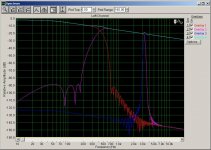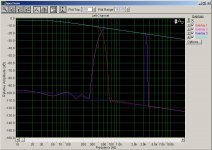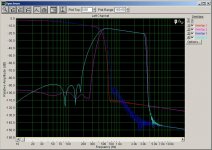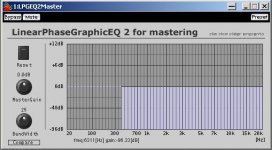ewildgoose said:Sorry to hear that....
DEQX doesn't do anything that you can't do with a PC. However, I think you are right that generating decent crossovers is not trivial.
Hi Ed
Your right. At this point though, I'm just fed up of swapping/playing around and just want to get back to listening to music rather than faults in the frontend. The DEQX has a proven track record with both DIY'ers and OEM customers, so I believe this will finally give me peace. It doesn't offer anything like the power of DB's DRC filters though so I'll probably still use the PC for that if it provides definite improvements.
Have you tried simply using NT crossovers as generated by the program written by Uli Brueggeman? You can get a simple program to generate these from http://www.duffroomcorrection.com and if you contact him directly via the DRC mailing list I think he will give you some advice on using it.
I haven't Ed. I may look into in the future but for now I'll see how the DEQX stacks up.
Good luck
Thanks.
DarkOne said:It's hard to believe that this great thread is about to end as a fault. I've been so much interested in making PC XO, that I nearly ordered new soud card and began development of 6 chanel amp with all the features one would need.
Anyway, someone had to try this method to say that it's not the right way (Thanks ShinOBIWAN), but I'm sure that it's not so bad and maybe some new plugins would work perfectly.
So I'm looking forward to your next posts about this and new experiences with perfectly working PC XO.
Good luck guys
Regards
Robo
Hi Robo
Don't be down on the PC XO thing. I tried it and it didn't work for me and that could be for a few reasons like hardware and software setup/incompatabilities, XO points, XO slopes, choice of plugin, speakers you using etc.
I've had my speaker sounding really great in the past but now I've noticed this its just took the shine off it and I'm almost certain its something only recently introduced when I made the switch to the RME fireface.
Give it a go but don't spend daft money like I've done. It was a waste and in hindsight I really wish I just went for the DEQX.
I've greatly enjoyed playing around with all this stuff though. For me DRC is the real attraction of the PC now but I'll keep revisiting the XO side of things, progress here is almost certain.
Ed:
Any input on my questions regarding video sync (couple pages back)? I'm buying the hardware to make another dedicated linux pc right now to put brutefir/drc into full effect.
Any input on my questions regarding video sync (couple pages back)? I'm buying the hardware to make another dedicated linux pc right now to put brutefir/drc into full effect.
Well, the answer is obviously that you need some way to delay the video! It's not easy, but it can be done
In my case, as you can see from my details on http://www.duffroomcorrection.com I simply do everything on the PC using Mythtv for all video duties. This means that the DVD player apps can deal with video delay for me
Ed W
In my case, as you can see from my details on http://www.duffroomcorrection.com I simply do everything on the PC using Mythtv for all video duties. This means that the DVD player apps can deal with video delay for me
Ed W
Nice thread to read, and reavealing conclusion. Most disadvantages of of the PC approach are obvious, but I still don't get some stuff:
- ringing: why would the DEQX have less ringing. It also uses FIR filters. Basicly, there is no difference. If you had ringing, then blame your filters, and not your complete setup.
- delay: if you would use the same amount of filter tabs as the DEQX uses, you would get roughtly the same delay with your PC setup.
- ringing: why would the DEQX have less ringing. It also uses FIR filters. Basicly, there is no difference. If you had ringing, then blame your filters, and not your complete setup.
- delay: if you would use the same amount of filter tabs as the DEQX uses, you would get roughtly the same delay with your PC setup.
4real said:Nice thread to read, and reavealing conclusion. Most disadvantages of of the PC approach are obvious, but I still don't get some stuff:
- ringing: why would the DEQX have less ringing. It also uses FIR filters. Basicly, there is no difference. If you had ringing, then blame your filters, and not your complete setup.
- delay: if you would use the same amount of filter tabs as the DEQX uses, you would get roughtly the same delay with your PC setup.
All FIR filters are definitely not equal, ask Ed as he has a greater understanding of the finer points than I.
At the moment I want something that's stable, sounds good and is transparent in operation - the PC can be those things but with considerable effort and since I've already been playing around with the whole thing for month's and month's now, I've decided that I'd rather have an easier life.
About the DEQX; its been very favourably reviewed by some of the bigger names such as stereophile, absolute sound, vance dickason/voice coil magazine, 6moons and adopted as the heart of some highend loudspeakers by companies such as NHT, Magico, Overkill Audio and a few other's. If there was a noticable problem as I've described with my PC setup then I really don't think any of those guys would have reviewed the equipment so favourably.
I think the main thing to remember is that the DEQX is a purpose built hardware solution rather than the mismash of plugins and soundcard that you push in the right direction with the PC setup.
Finally the delay of the DEQX is around 10ms vs. 70-100ms for the PC setup. So they are not equal there either.
Hi Vil,
The pre-echo artifacts are down at -85dB which should be clearly inaudible, yet I hear those artifacts quite clearly.
I'd also say that the free plugin looks like the better performer in this area. Which one is it exactly?
The pre-echo artifacts are down at -85dB which should be clearly inaudible, yet I hear those artifacts quite clearly.
I'd also say that the free plugin looks like the better performer in this area. Which one is it exactly?
ShinOBIWAN said:Hi Vil,
The pre-echo artifacts are down at -85dB which should be clearly inaudible, yet I hear those artifacts quite clearly.
Hi ShinOBIWAN:
We cannot say anything about the pre-echo artifacts from the graphs of Vil, since they only show freq. response.
What we see at -85dB is stopband attenuation (pretty good but it can be bettered ;-) )
Cheers,
Roberto
ShinOBIWAN said:All FIR filters are definitely not equal, ask Ed as he has a greater understanding of the finer points than I.
That's exactly my point 😉 Blaim the fiters not the complete solution.
But the other disadvantages are of course very obvious.
Myself, I'm still not sure what to do. The DEQX is far to expensive for me, so I would have to choose a IIR solution like the DCX in stead.
What you are seeing is simply the reason that the hifi community tends to espouse digital as "making things worse" and why there is this myth that simpler is better...
Basically digital is VERY hard to get right. This does NOT mean that digital is bad, merely that you have to be precisely right to get an improvement over analogue style filtering, but that if you get it slightly wrong then it's easy to have something much worse. Basically it's a bit of a knife edge and easy to mess everything up
Creation of the filters is the main issue. Old CD players had a poor sound, probably because of the poorly designed output filters. These days everyone raves around different upsamplers, presumably this is really an implicit rave about different types of output filter again...
Other issues if you read about analogue style filtering are that certain filters have theoretically good performance, but in practice if the drivers are misaligned (which they must be at some angle if the drivers aren't coincident), then the performance is very poor. This was the substance of the original LR crossover paper which showed that LR had an attractive property of being "good" in the face of misalignments of the drivers.
IIR filters have very low delay and can emulate all traditional analogue filters. FIR filters can also emulate the same for a similar theoretical low output delay (but you need to add in the delay of the convolver). However, with FIR you can also trade additional delay for the ability to affect phase - this means that with FIR filters you can generate crossovers which are phase perfect, but at the expense of some additional delay in the audio path
Further tradeoffs occur when you trade steepness of filter with ripple in the passband (bad) and ripple in the stop band (hopefully inaudible) and also total filter attenuation.
FIR can also cause what is called "pre-echo" where there is a garble ahead of transients in the music. These are suprisingly easy to hear at high freqs and even pre-echo with large amounts of attenuation can be audible if the pre-echo time is large.
This is a badly documented subject. Suffice to summarise that pre-echo is inaudible at bass freqs, but phase delay can be audible at bass freqs (hence use linear phase). At high freqs, phase is totally inaudible, but pre-echo is very audible (hence don't use linear phase filters or no more than a very small amount of pre-echo).
There are loads of different ways to design filters. I suggest that unless you know what you are doing, then why not stick with traditional analogue shapes like LR4 or NT filters. You can create these filters in Matlab/Octave and there are a small number of tools to generate the same. For linear phase then use a program which has good reviews and is capable of generating decent filters - these are most likely to be beneficial for bass level crossovers and will cause largish delays in the audio processing.
I hope this gives a reasonable background on the subject. Please see the wiki for some pointers on code to generate filters. Please feel free to take these words and write up a better treatsie on the subject on the wiki... (someone? please?)
http://www.duffroomcorrection.com
Good luck
Ed W
Basically digital is VERY hard to get right. This does NOT mean that digital is bad, merely that you have to be precisely right to get an improvement over analogue style filtering, but that if you get it slightly wrong then it's easy to have something much worse. Basically it's a bit of a knife edge and easy to mess everything up
Creation of the filters is the main issue. Old CD players had a poor sound, probably because of the poorly designed output filters. These days everyone raves around different upsamplers, presumably this is really an implicit rave about different types of output filter again...
Other issues if you read about analogue style filtering are that certain filters have theoretically good performance, but in practice if the drivers are misaligned (which they must be at some angle if the drivers aren't coincident), then the performance is very poor. This was the substance of the original LR crossover paper which showed that LR had an attractive property of being "good" in the face of misalignments of the drivers.
IIR filters have very low delay and can emulate all traditional analogue filters. FIR filters can also emulate the same for a similar theoretical low output delay (but you need to add in the delay of the convolver). However, with FIR you can also trade additional delay for the ability to affect phase - this means that with FIR filters you can generate crossovers which are phase perfect, but at the expense of some additional delay in the audio path
Further tradeoffs occur when you trade steepness of filter with ripple in the passband (bad) and ripple in the stop band (hopefully inaudible) and also total filter attenuation.
FIR can also cause what is called "pre-echo" where there is a garble ahead of transients in the music. These are suprisingly easy to hear at high freqs and even pre-echo with large amounts of attenuation can be audible if the pre-echo time is large.
This is a badly documented subject. Suffice to summarise that pre-echo is inaudible at bass freqs, but phase delay can be audible at bass freqs (hence use linear phase). At high freqs, phase is totally inaudible, but pre-echo is very audible (hence don't use linear phase filters or no more than a very small amount of pre-echo).
There are loads of different ways to design filters. I suggest that unless you know what you are doing, then why not stick with traditional analogue shapes like LR4 or NT filters. You can create these filters in Matlab/Octave and there are a small number of tools to generate the same. For linear phase then use a program which has good reviews and is capable of generating decent filters - these are most likely to be beneficial for bass level crossovers and will cause largish delays in the audio processing.
I hope this gives a reasonable background on the subject. Please see the wiki for some pointers on code to generate filters. Please feel free to take these words and write up a better treatsie on the subject on the wiki... (someone? please?)
http://www.duffroomcorrection.com
Good luck
Ed W
Which method does the DEQ use ?
Is it basic FIR filtering followed by room correction ? In that case you could generate a basic FIR filter as stated above and correct dips and bumbs in the correction filter.
You could even convolve each of the crossover filters with the correction filter offline, such that each channel only has to go through the convolver once.
Is it basic FIR filtering followed by room correction ? In that case you could generate a basic FIR filter as stated above and correct dips and bumbs in the correction filter.
You could even convolve each of the crossover filters with the correction filter offline, such that each channel only has to go through the convolver once.
They claim to use IIR in many places and they also claim a patent on modifying phase using their IIR filters. If you download the manual I think it shows that you can actually generate many different types of filters and it dynamically shows you the delay incured by your filter of choice
Personally I was only marginally sold on the DEQX, but to be fair it's a nice interface (although rather complicated) and the box certainly does a lot for the price. Sure you can do the same thing with DIY, but you do need to know a lot about what you are doing. (And the DEQX also has a volume control!)
Their room correction appears to be nothing more than a parametric EQ solution though?
Ed
Personally I was only marginally sold on the DEQX, but to be fair it's a nice interface (although rather complicated) and the box certainly does a lot for the price. Sure you can do the same thing with DIY, but you do need to know a lot about what you are doing. (And the DEQX also has a volume control!)
Their room correction appears to be nothing more than a parametric EQ solution though?
Ed
ewildgoose said:[... lots of text ...]
Thanks for telling me, but I already knew all of this

Personally I wanted to use Brutefir with a custom webinterface to controll it all. Something like BruteEQ, but more advanced and a more real-time like interface.
ewildgoose said:They claim to use IIR in many places and they also claim a patent on modifying phase using their IIR filters. If you download the manual I think it shows that you can actually generate many different types of filters and it dynamically shows you the delay incured by your filter of choice
Personally I was only marginally sold on the DEQX, but to be fair it's a nice interface (although rather complicated) and the box certainly does a lot for the price. Sure you can do the same thing with DIY, but you do need to know a lot about what you are doing. (And the DEQX also has a volume control!)
Their room correction appears to be nothing more than a parametric EQ solution though?
Ed
Kim from DEQX explained what exactly the unit does:
It offers the choice of linear phase FIR filters for the crossover, or alternatively you've also got the choice various orders of butterworth and linkwitz-riley types, these are of course IIR.
For the phase correction it uses delay lines between drive units and also minimum phase FIR filters in the pass bands.
Room correction has the option of IIR PEQ for just the low end (upto around 300-400hz recommended) or full time/phase alignment ala. Dennis's DRC program. To use this option you must capture a room impulse with the DEQX and then email this data to DEQX who modify and optimise room filter for you.
One of the big advantages of using just PEQ on the low end is that you don't end up mashing up the midrange and top end with run-of-the-mill microphones such as the ECM8000. I can full relate to this when I compared my original impulse captured with a very nice hired Earthworks M51 and mic-pre compared to my ECM8000. The difference was quite apparent and the ECM8000 sounded like a cloud had passed over the treble and upper midrange - very poor. I quickly switched back to M51 impulse but its hardly economically to own one of these mics since they cost $1000+.
With PEQ you only touch the most problematic area - bass and its not quite like the sledgehammer that DRC is.
4real said:
That's exactly my point 😉 Blaim the fiters not the complete solution.
But the other disadvantages are of course very obvious.
Myself, I'm still not sure what to do. The DEQX is far to expensive for me, so I would have to choose a IIR solution like the DCX in stead.
If you read my post on the problem you would see that I have indeed tried quite a few plugin, including IIR... still think its the plugins

There's a few folks on here doing exactly the same as I tried and they don't seem to be complaining. The more I think about it the more I suspect the problem lies with my setup. Swapping around incessantly general does introduce bugs, but swapping around has become expensive and at this stage I just want something that works.
I had the DCX before I tried all this, my advice would be to avoid. Average at best would be my first thought but personally I'd rather go with passive than that route. The DCX is cheaper than the other methods for a reason.
If you think that FIR filters are disadvantaged compared to the other methods available, you need to look and hear again. Like I said in my previous post, check out the DEQX reviews from publications that generally prefer the old methods and you'll quickly realise that it can turn average systems into a heavy weight one and top flight system into something pretty special. This is my experience with the PC setup in the past and something that neither passive nor analogue active will ever be able to do.
4real said:
Thanks for telling me, but I already knew all of this
Personally I wanted to use Brutefir with a custom webinterface to controll it all. Something like BruteEQ, but more advanced and a more real-time like interface.
If you already knew all that then why are you generalising filter characteristics and suggesting the wrong things?
Use the DEQX since a latency of 10ms is pretty much realtime and you can make changes on the fly.
The console method also allows realtime adjustments.
- Status
- Not open for further replies.
- Home
- Source & Line
- PC Based
- A how to for a PC XO.



